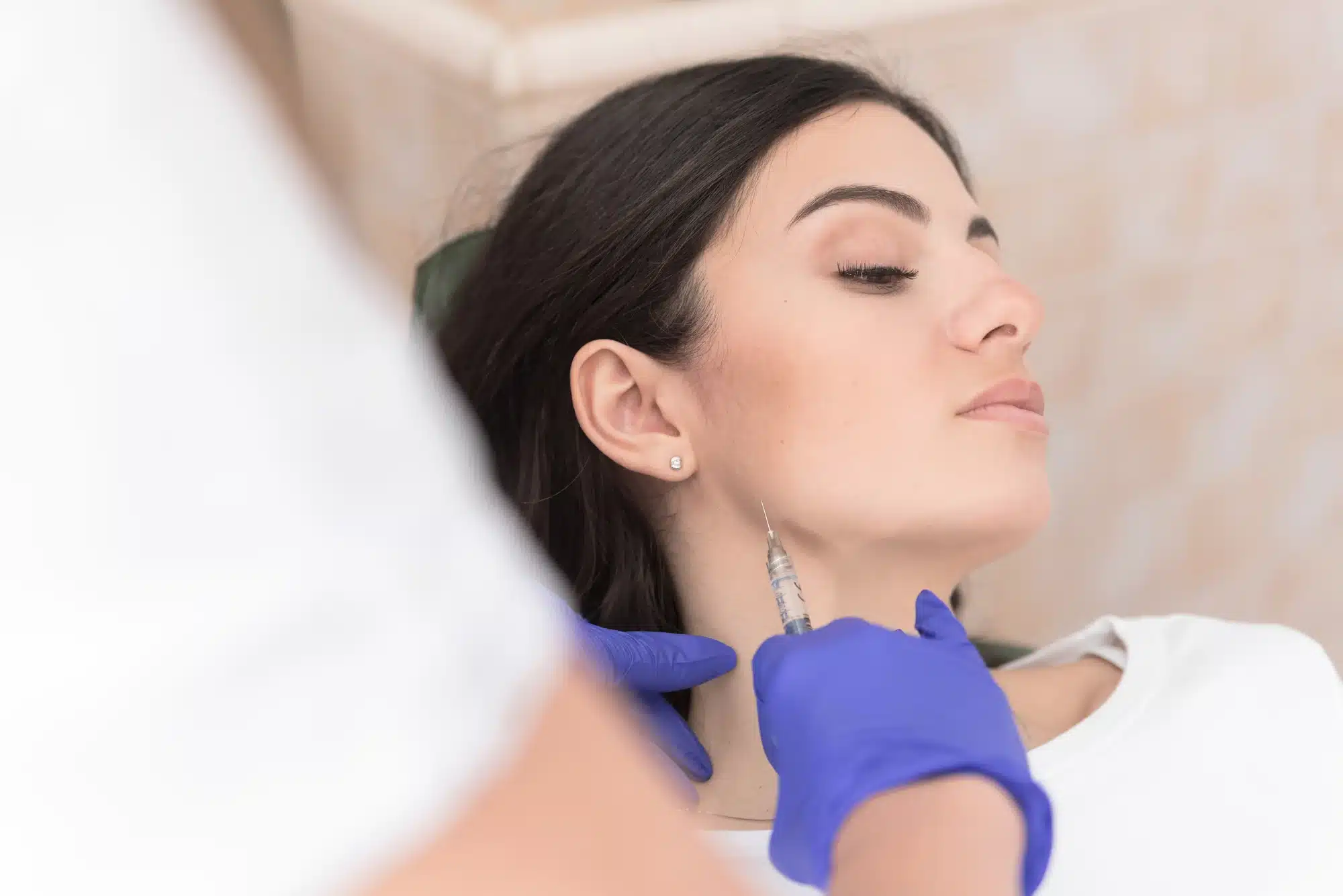Business Hours: Monday-Friday 9AM-6PM EST

Leveraging Botox for Excessive Drooling
David Fuller
Last Updated On: April 18, 2024
Key Takeaways
- Effective Treatment Option: BOTOX® injections offer a valuable tool for managing sialorrhea (excessive drooling) in both adult and pediatric patients.
- Optimizing Outcomes: Understanding the mechanism of action, treatment procedure, and injection sites is crucial for achieving the best results for your patients.
- Evidence-Based Approach: Clinical studies support the efficacy of BOTOX® for excessive drooling. However, being aware of potential complications and side effects is important.
- Parkinson’s Disease Considerations: BOTOX® therapy shows promise for addressing drooling associated with conditions affecting the central nervous system, including Parkinson’s disease, ALS, etc. But, further research is needed to determine its role in this patient population.
- Holistic Management: Practical tips and incorporating patient perspectives can enhance the overall success of BOTOX® treatment for sialorrhea.
Impact of Sialorrhea on Health
Regardless of the type, sialorrhea can lead to various complications, including,
- Skin breakdown around the mouth (perioral maceration) due to constant moisture.
- Bad breath (halitosis).
- Dehydration
- Speech difficulties (dysarthria) due to hampered oral motor function.
- Aspiration risk of saliva or food into the lungs, especially if reflexes are weakened.
Causes of Sialorrhea
Hypersalivation arises from several underlying mechanisms, including enlarged salivary glands, heightened saliva production, and compromised swallowing mechanisms due to inadequate neuromuscular control of the oral muscles.
- Children: Mental Retardation, Cerebral Palsy (CP)
- Adults: Stroke, Parkinson’s Disease (PD), Amyotrophic Lateral Sclerosis (ALS), Pseudobulbar Palsy, Bulbar Palsy
- Systemic: Side effects of medications, including antipsychotics (e.g., clozapine), tranquilizers, and anticonvulsants; Exposure to substances like mercury vapor, pesticides, and poisonous mushrooms; Rabies, Gastroesophageal reflux
- Local: Dental caries, Teething, Peritonsillar abscess, Tonsillitis. Fortunately, these concerns can be effectively managed with a combination of medications and/or cosmetic dental treatments.
- Physiological: Hormonal changes during pregnancy, especially in cases of hyperemesis gravidarum.
- Anatomic abnormalities: Nasal Blockage, Dental Malocclusion, Orthodontic Problems, Macroglossia, Head and Neck Surgical Defects, Oral Incompetence.
Sialorrhea can manifest in two ways: anterior sialorrhea, where saliva dribbles uncontrollably over the lower lip, and posterior sialorrhea, where saliva accumulates in the back of the throat.
Patient Assessment for Sialorrhea
Effective management of sialorrhea requires a thorough examination to determine the underlying cause, severity, and its impact on quality of life. This helps guide treatment decisions and establish a personalized plan for optimal outcomes.
A detailed medical and social history is crucial. Information should be gathered from both the patient and their caregiver (if applicable) to understand:
- Severity: Evaluate the frequency and volume of drooling.
- Impact on Daily Life: Assess the functional limitations and psychosocial implications of sialorrhea on the patient and caregiver.
- Medications: Review current medications to identify any potential contributors to sialorrhea.
- Other Medical Conditions: Investigate underlying medical conditions like Parkinson’s disease, stroke, or intellectual disability that may influence sialorrhea management.

Physical Examination
A comprehensive physical examination should include:
- Oral Cavity: Evaluate for signs of inflammation, sores, dental problems, tongue mobility, and tonsillar hypertrophy.3
- Facial Structure: Assess for nasal blockage, malocclusion (improper bite), and jaw stability.
- Neurological Function: Evaluate alertness, swallowing ability, motor skills, and sensory function.
- Nutritional Status: Assess hydration and nutritional intake to identify potential dehydration or aspiration risks.
- Head Posture: Evaluate head position for any abnormal posturing that might contribute to drooling.
- Emotional State: Assess for signs of anxiety or depression that could be associated with sialorrhea.
Sialorrhea Quantification
Healthcare practitioners can also assess drooling in two ways: through objective methods like scans and collection devices used in research and through subjective reports from patients or caregivers, like the Drooling Frequency and Severity Scale.
In addition, the following modalities are valuable in confirming the diagnosis:
- Lateral Neck Film
- Modified Barium Swallow
- Radiosialography
- Audiogram
- Flexible nasopharyngoscopy
Effective sialorrhea management hinges on a multidisciplinary team approach. After assessment, a multidisciplinary team consisting of an otolaryngologist, pediatric dentist, speech pathologist, and physical therapist discuss different physical and medical interventions before proceeding with further treatment.
Managing Sialorrhea With a Multi-Pronged Approach
The best treatment for drooling depends on the underlying cause and the individual’s specific needs. Conservative treatments such as oral-motor exercises, intraoral palatal training devices, and changes in diet can be helpful. Oral anticholinergic agents such as transdermal scopolamine, glycopyrrolate, and benztropine can also be used to decrease salivary production. Behavioral therapy, including verbal and auditory cues, is used to encourage more frequent and efficient swallowing. BOTOX® therapy for drooling (injecting the neurotoxin into the parotid and submandibular glands) has been shown to be effective in reducing drooling in various neuromuscular conditions.
Surgical techniques such as salivary gland excision, denervation, and ligation of salivary ducts are reserved for refractory cases. It’s generally deferred until the patient is at least six years old to allow for complete maturation of oral motor function and coordination. A dentist can help determine the most appropriate course of treatment for each case.
The Role of BOTOX® in Managing Excessive Salivation
A recent meta-analysis assessed BOTOX® efficacy in treating sialorrhea in adult patients with CNS disorders. Using the Drooling Severity and Frequency Scale (DSFS), the analysis found significantly lower DSFS scores in BOTOX®-treated groups than controls. The resulting reduced drooling severity suggests BOTOX® injection for excessive salivation is a clinically effective option in adult patients with CNS disorders.
Mechanism of Action of BOTOX® in Reducing Salivary Gland Activity
BOTOX®, or Botulinum toxin type A, affects hypersalivation through a targeted inhibition of the parasympathetic nervous system. BoNT-A acts via a two-pronged attack to reduce saliva production. It binds to presynaptic cholinergic nerve terminals in the autonomic ganglia and hinders the formation of the SNARE complex essential for acetylcholine (ACh) release. This in turn inhibits ACh release, leading to temporary paralysis of salivary acinar cells and a consequent decrease in saliva flow, as observed in medical studies.
Types of BOTOX® and Dosing:
Three types of botulinum toxin A are FDA-approved for sialorrhea treatment:
- OnabotulinumtoxinA (BOTOX®)
- AbobotulinumtoxinA (DYSPORT®)
- IncobotulinumtoxinA (XEOMIN®)
- Other brands – BOCOUTURE®, BOTULAX® and NABOTA®
The specific toxin type and dosage used vary depending on individual factors, but the general range falls within:
- BOTOX®: 10-100 Units
- DYSPORT®: 20-300 Units
Interestingly, a positive response to BOTOX® injections for sialorrhea can be an indicator of potentially successful surgical outcomes for sialorrhea. Conversely, a poor response may suggest that surgery might not be as beneficial, possibly due to contributions from minor salivary glands not affected by BOTOX® injections.
Injection Sites for BOTOX® in the Treatment of Excessive Drooling
Parotid Gland:
- The optimal injection site for targeting the parotid gland is typically found midway between the tragus and the jaw angle.
- Maintaining precision while injecting is important, given the larger volume of the parotid gland.
Submandibular Gland:
- The recommended injection site is typically positioned one finger width below the mandibular bone and in the distal third between the jaw angle and chin apex.
- For optimal reduction of saliva secretion, both the submandibular and parotid glands should be targeted with simultaneous injections. This approach is particularly effective under resting and stimulated conditions.
Using ultrasound-guided visualization while injecting the parotid and submandibular glands has shown targeted deposition and minimized risk of unwanted diffusion into neighboring facial muscles — a definite tool to mitigate potential side effects.
Pediatric BOTOX® Injections for Salivary Glands
On an encouraging note, studies indicate that BoNT-A injections offer a safe and reversible treatment option for drooling in children, especially with cerebral palsy (CP). The duration of effectiveness lasts approximately 3-4 months. Therefore, repeat injections are usually recommended for sustaining benefits.
Although the safe dosage for BOTOX® in children with drooling is under study, but initial research suggests a limit of 4 units/kg.
The Bad – Adverse Events Associated with BOTOX® Injections
While BOTOX® (onabotulinumtoxinA) injections are generally considered safe for treating drooling (sialorrhea), adverse reactions, although rare, can occur. Here’s a summary of potential complications:
- Dysphagia
- Aspiration pneumonia
- Xerostomia
- Dysarthria
- Speech difficulties
- Coughing
- Chewing and feeding difficulties
- Saliva thickening
- Weakened oral musculature
Conclusion
While sialorrhea presents a challenge, administering BOTOX® injections for excessive drooling shows great promise. Targeting botulinum toxin injections to salivary glands and disrupting the mechanisms that drive excessive saliva production, these injections effectively alleviate symptoms and improve quality of life. This approach complements the existing range of treatments, which include conservative measures like oral motor therapy and pharmacological interventions, as well as surgical options for more severe cases. As research and collaboration continue, the future of sialorrhea management looks bright, offering hope for even more effective interventions.
If you’re interested in sourcing authentic BOTOX® injections for sialorrhea treatment, book a meeting with our sales team.
FAQs
- Can BOTOX® stop drooling?
BOTOX® (onabotulinumtoxinA) can be a successful treatment for drooling (sialorrhea) with conditions such as cerebral palsy, Parkinson’s disease, and other neuromuscular disorders. It works by reducing the activity of the salivary glands and decreasing the amount of saliva produced. However, it’s important to note that BOTOX® may not completely stop drooling and may be more effective for some patients than others.
- What is the best treatment for drooling?
The best treatment for drooling varies based on its cause and individual needs. Options include oral-motor exercises, palatal training devices, dietary adjustments, and anticholinergic medications like glycopyrrolate and benztropine. BOTOX® injections into salivary glands are also effective in reducing drooling, while surgery is reserved for severe cases. A dentist can help determine the most appropriate course of treatment for each case.
- What are the side effects of BOTOX® for Parkinson’s drooling?
As with any medical treatment, BOTOX® can have side effects. For drooling associated with Parkinson’s disease, these may include
- Temporary dry mouth,
- Difficulty swallowing,
- Facial weakness.
- Minimal bleeding,
- Low risk of infection.
- Side effects and allergic reactions from anesthesia.
- How long does BOTOX® last for drooling?
The effects of BOTOX® for drooling typically last for 3-6 months. After this time, the muscles will gradually regain function, and drooling may resume. Repeat injections are usually needed to maintain the benefits.
References
- Güvenç IA. Sialorrhea: A Guide to Etiology, Assessment, and Management. In: Salivary Glands – New Approaches in Diagnostics and Treatment. Published December 6, 2018. DOI: 10.5772/intechopen.82619.
- Lovato, A., Restivo, D. A., Ottaviano, G., Marioni, G., & Marchese-Ragona, R. (2017). Botulinum toxin therapy: Functional silencing of salivary disorders. Acta Otorhinolaryngologica Italica, 37(2), 168-171. https://doi.org/10.14639/0392-100X-1608
- Jost, W.H., Bäumer, T., Laskawi, R. et al. Therapy of Sialorrhea with Botulinum Neurotoxin. Neurol Ther 8, 273–288 (2019). https://doi.org/10.1007/s40120-019-00155-6
- Hung, A., Liao, L., Lin, P., Hsu, J. C., Guo, H., & Lin, C. (2021). Botulinum Toxin Injections for Treatment of Drooling in Children with Cerebral Palsy: A Systematic Review and Meta-Analysis. Children, 8(12). https://doi.org/10.3390/children8121089
- Heikel, T., Patel, S., Ziai, K., Shah, S. J., & Lighthall, J. G. (2022). Botulinum Toxin A in the Management of Pediatric Sialorrhea: A Systematic Review. Annals of Otology, Rhinology & Laryngology. https://doi.org/10.1177/00034894221078365
- Chen, C., Su, Y., Chen, H., & Lin, Y. (2022). Botulinum Toxin for Drooling in Adults with Diseases of the Central Nervous System: A Meta-Analysis. Healthcare, 11(13), 1956. https://doi.org/10.3390/healthcare11131956
Products
Cart
Log In
Newsletter
Subscribe for exclusive offers and updates on new arrivals
[email protected]
Share feedback at:
[email protected]
Working Hours
Monday to Friday: 9 AM to 6 PM (EST)
Copyright 2024. Med Supply Solutions